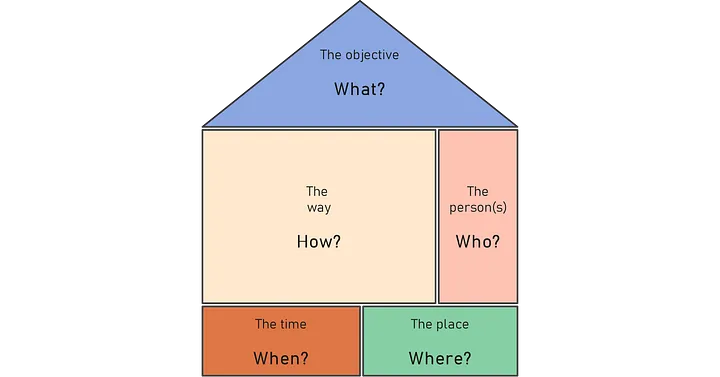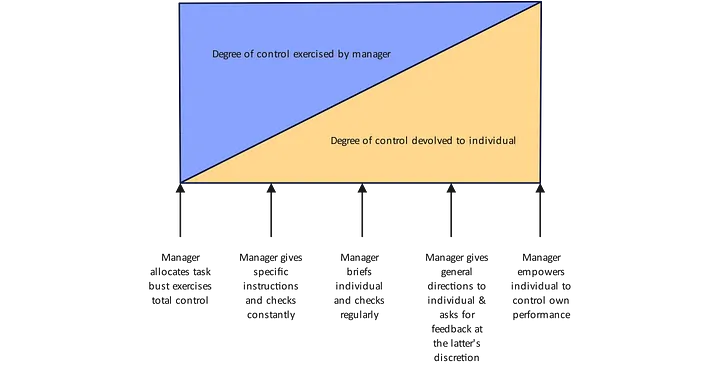The context
Being a manager is a tough and challenging job, especially when the fundamental resource of all time is scarce. Add conflicting roles and obscure goals; you have an explosive mix to handle.
‘’So little time, so much to do,’’ Louis Armstrong would say. Being a project manager at industrial refrigeration installations for 16 years and an avid bookworm for all my life, I came up with a practical and concise tool to assist me with my tasks. This tool I am delighted to present you with this article.
Feeling the pressure on my back and searching through a lot of the bibliography, I ended up in a well-known framework to journalists as the ‘’5 W’s and H’’. It is a set of direct lean questions based only on adjectives. The basic questions are:
· Who?
· What?
· Where?
· When?
· Why?
· How?
Inspired by the Quality House, a tool used by Quality Department to show how customer requirements relate to the ways and methods companies use to achieve them¹ , and the above framework, I created the House of Command tool.
The tool
The House of Command has five pillars. Each pillar concerns a fundamental question the manager should ask to arrange his job more efficiently.
We shouldn’t forget that a manager’s job is to develop and manage people not performing tasks², and as every manager knows, most of the time, dealing with people can be far more tricky than completing tasks. I found the hard way that telling people what to do or not to do can easily be caught up to the nest of complexity.
I am very fond of symbolism because a symbol, like a picture, can depict a thousand words; you can say many things at once and artistically convey multiple meanings. The word “House” is for expressing a reliable and ordered manner. “Command” is for providing clear order when things are at high stakes. Like mother nature³, companies establish a hierarchy that tells people, teams, and departments who is responsible for what. You have increased efficiency, clear direction, stability, accountability, responsibility, and understanding with a transparent chain of command⁴.
In the following scheme, the House of Command tool:

Scheme 1 : House of Command Tool / Image created by author
Symbolism is present in the structure of the House. The building blocks of the House are Time and Place or “When?” and “Where?”. We live in time and space. Everything we do is in that context. At the primary level are people who try to find ways to accomplish their needs in a given time and place. But all of the previous can be blind forces without the Objective or “What?”. Seeing as the roof of the House or as an arrow, Objectives or goals give direction to human action.
So, let’s go exploring further the components of the tool.
What? (The Objective)
“Tell me what you want.” This phrase is already a cliché in most modern movies, especially those that belong to the genre of action, adventure, and crime. The scenes are archetypically the same: the main hero, the protagonist, usually in a difficult position, must make a costly trade-off with someone else, mainly the bad guy.
Always start with what you want. Objectives or goals are the desired outcomes of a task, activity, process, or project. Without them, you don’t know your destination. Remember that goals are clear, concise, and specific outcomes, not intentions or mere wishes. Many people get confused and have trouble discerning goals from preferences.
A preference is an intention that is general, cloudy, and mainly emotional, but it’s beneficial because it motivates; it is the source of energy, although it is not enough. At this point, as I often slip into being too emotional, I remember the famous saying: “The road to hell is paved with good intentions.” When in that phase, someone needs logic.
The most common tool for goal setting is the SMART framework which stands for :
· Specific
· Measurable
· Achievable
· Realistic
· Time bounded
A real example of the SMART Goals framework from some of my customers is the following :
Specific: Chocolate producer “Chocobite” wants to reduce its electricity consumption by 30% due to high energy costs that affect production.
Measurable: “Chocobite” can measure electricity consumption, and as a result, it can track progress relative to the 30% reduction goal.
Achievable: The company can accomplish its goals by implementing air-to-water heat pumps and solar heating instead of electrical resistances to its production.
Realistic: The goal is grounded because the technology available to accomplish it is well-known and guarantees a reduction of 30%. A further decrease in energy consumption at 90% is unrealistic.
Time bounded: “Chocobite” wants to achieve the goal in the next two months.
So, every time you try to figure out what to do and accomplish, articulate it in the SMART framework to have clarity, consistency, and accountability.
How? (The Way)
Amelia Earhart once said: “The most effective way to do it is to do it.” A way is a series of tasks and activities someone employs to accomplish a goal. Some ways are in the form of prescriptions as detailed steps, while others are more abstract, based mainly on the situation and the person who employs them.
No matter the way, there must always be a way — precisely, a method and know-how that will help everyone accomplish the goal. A manager’s responsibility is to provide this method and give precise directions on how to implement it. On the other hand, it is the subordinate’s responsibility to implement the course best. Keep in mind that the process is highly dynamic; it contains many questions and answers, training, agreements, and disagreements, and it is open to new ideas and improvement.
A good idea I came up with during my training to subordinate industrial refrigeration engineers is to provide a documented, structured way of doing their job. But not in the usual, only letters classic document. I used images because of their visual power to convey meaning. Traditional tools like Microsoft Powerpoint are enough, but new tools appear like Canva.
Of course, in hasty situations, when you don’t have time to process data on Powerpoint or Canva, a clear and sound understanding is enough.
For those managers, executives, and professionals who want to go deeper, some approaches can help them refine their ways of doing things constantly. Lean management, continuous improvement, or Kaizen are the most popular. Since this article does not present those methodologies, I can suggest two links to give you some valuable information.
An excellent website, especially for beginners, which is very informative and easy you can find it here.
Also, you can use software to assist you in implementing lean and Kaizen. I found Clickup user-friendly, and you can find it here.
Who? (The person(s) )
“If you want to do a few small things right, do them yourself. If you want to do great things and make a big impact, learn to delegate,” says John Maxwell. This block of the House of Command is about delegation.
Many times managing people can be challenging because delegation is hard. Despite being a business owner and project manager for 16 years, I still struggle to delegate. Moreover, everyone I know who does a managerial job has similar troubles. I can tell you surely from personal experience and others’ experience that it gets better through the years.
Concerning delegation, the most practical tips I have found in the bibliography are in M. Armstrong’s book: How to be an even better manager, a complete A-Z of proven techniques and essential skills⁵. You can purchase it from Amazon or any other online bookstore.
When you are about to delegate, it can be helpful to you to remember the following table :

Scheme 3 : The sequence of delegation. Adopted from Armostrong (2004). Image created by author
Now the main question is when to delegate. Some practical tips are the following⁶ :
You delegate when :
· you have more work than you can effectively carry out yourself;
· you can’t allocate sufficient time to your priority tasks;
· you want to develop your subordinate;
· the job can be done adequately by your subordinate;
The things you delegate are⁷ :
· repetitive and routine tasks.
· aspects requiring expertise.
So now we come to this section’s most crucial element: choosing who does the work. According to Armstrong, there are two criteria: willingness to learn the job and trust⁸. An effective manager should delegate to someone with the will to do and understand the work. Trust is the foundation of every relationship, whether personal, professional, social, friendly, formal, or informal⁹. Trust is an edifice; that is why we say in everyday language that we build trust. To find out whom you can trust, firstly, delegate smaller and less critical tasks and increasingly give people more scope to understand how far they can go and observe how they do it. Trust is a step-by-step process.
Some final bits of advice about delegation I found meaningful, so I would like to express them without any change¹⁰, are:
“If you can’t do something yourself, find someone who can-then let him do it in his own sweet way.’’
“You should always delegate by the results you expect.”
When? (The time)
“Time is money,” supposedly told Benjamin Franklin. The fact is that time is the most precious and scarce resource we have. It is finite and, unfortunately, very relative. We don’t live forever. Processes, whether natural or artificial, are time bounded.
Business processes are getting increasingly complex, requiring time for successful completion. Simultaneously, there is a growing need for faster execution and delivery. Every manager, especially those working in production, struggles with the relationship between time and cost. A product that demands time is a product that costs. Controlling costs is to prevent time.
Every manager must consider time. Every task, every project, every duty, and every process must be time-oriented, which means that everything has a beginning and an end. So the main sub-questions are :
· When is the start?
· When is the finish?
Is it simple as that? Yes and no. Yes, if you are dealing with simple tasks and not if you are facing more complex issues like projects with many interrelated tasks.
As a project manager at major industrial refrigeration projects, I find the classification of tasks handy as Microsoft Project has it. This classification is beneficial for more complex cases like projects.
Everybody who wants to know about the classification can find it here.
Where? (The Place)
“O brother, where art thou?” is the title of the famous Ethan and Joel Coen movie in 2000 in which three escaped convicts search for hidden treasure while a relentless lawman pursues them in the USA deep south of the 1930s¹¹.
Everything someone does, it does it somewhere. For the House of Command to be complete, the place where the given goal is to accomplish must be clear and determined.
Even though nowadays, for most people, the place seems self-evident, for military strategists of all ages and marketing specialists, positioning is a crucial parameter. For example, most football teams are more potent at their home.
Choose wisely the place; it must provide a sense of safety, easiness, functionality, and for more technical tasks, ergonomy.
Epilogue
You may wonder the reason for omitting the “why?” question from the House of Command. Some may argue that if I didn’t do that, I wouldn’t have something more to say or another “new” idea to sell. Neither of them is true. It is a matter of scientific ideology.
To explain myself, I am, or at least try to be, as best as possible, a systems thinker. Systems thinking is a way of exploring and developing effective action by looking at connected wholes rather than separate parts¹².
System thinkers have a guiding principle: we shouldn’t ask “why?” but only “what?” and “how?”. “Why?” can make you wonder about such a dense web of complexity that, eventually, you will lose your orientation. On the other hand, “what?” and “how?” are more directive and practical. Those core questions are always helpful when you discuss with colleagues at work or with your children: they improve communication¹³.
To command is to control, and to control is to minimize risks and maximize performance. Try the next time you are going to practice management to use the House of Command. You will feel much better.
Bibliography
[1]: https://asq.org/quality-resources/house-of-quality
[2]: Harvard Business Review, Harvard Business Review Manager’s Handbook: The 17 skills leaders need to stand out, Harvard Business School Publishing Corporation, 2017, pages 22–23.
[3]: https://www.rootedinnature.org/complexity-order
[4]: https://www.indeed.com/career-advice/career-development/chain-of-command
[5]: Armstrong Michael, How to be an even better manager, a complete A-Z of proven techniques and essential skills, Kogan Page, 9TH edition, 2014, pages 160–168.
[6]: Armstrong, 2014, pages 161–162.
[7]: Armstrong, 2014, page 162.
[8]: Armstrong, 2014, pageS 162–163.
[9]: https://hbr.org/2020/05/begin-with-trust
[10]: Armstrong, 2014, page 164.
[11]: https://www.imdb.com/title/tt0190590/
[12]: Government Operational Research Service, Introduction to systems thinking, Government Office for Science, 2012, page 3
[13]: https://hbr.org/2021/10/stop-asking-why-and-start-asking-how


